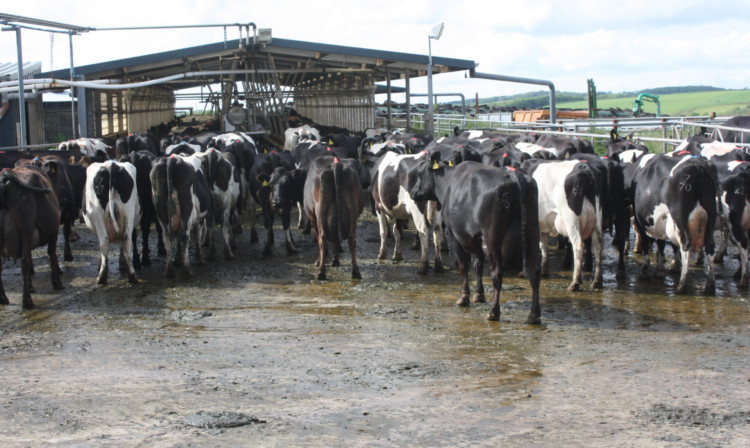There is currently much talk of producing milk and meat purely from grass, but few farmers can have turned the dream into a reality more effectively than brothers Chris and Nigel James.
They have turned their 1,900-acre farming business based at Stackpole Farm near Pembroke into a highly efficient dairy enterprise, milking 1,800 cows across four units.
“Our aim is simply to be amongst the lowest-cost milk producers in the UK,” Chris told a visiting group from the Edinburgh Agricultural Society.
The journey began in 1999, with Chris studying grass-based milk production systems in Ireland and New Zealand.
He saw the lowest costs per litre could only be achieved from spring calving the entire herd and building up production over the grass-growing season before drying off in the late autumn.
He also realised that efficient production under this system would only come with the correct type of cow. This meant introducing New Zealand Friesian bloodlines along with some Jersey and Ayrshire.
The influence can be seen on the herd, which is now made up of the sort of small, stocky cow that can survive out of doors for 12 months of the year.
The brothers’ father Harold, still an active observer of the business, took a tenancy of the main block of land from Keir and Cawdor Estates in 1980.
Under different ownership now, it remains a tenanted farm but that has not deterred the family from investing in the infrastructure needed to create a low-cost milk system.
The two main herds, each of 500 cows, run on adjacent farms.
One has been equipped with a straightforward wooden structure housing a 40 point swingover herringbone parlour.
The other has a massively strong 50-place rotary parlour custom built by an Australian engineer.
Both parlours are built with longevity and simplicity in mind, with neither having any frills such as automatic cluster removal. Complex electronics have been shunned in the over-riding drive for simplicity.
Two-man teams in each unit milk twice a day, with cows sometimes having to walk up to a mile to reach the parlours.
A network of broad and well-constructed hardcore roads extends out to each paddock, with cows run as a mob and often moved to fresh pasture after each milking.
“It is essential that cows are never crushed or feel bullied, so we give them plenty of room on the roads and on the access areas to the parlours,” said Chris.
The cows are not pushed to yield beyond their natural capability, and Chris told the visitors he was content with an average of 5,000 litres per lactation.
More intensive systems might yield 8,000 to 10,000 litres but could not compete on cost per litre.
Chris and Nigel do not expect to feed more than between half a tonne to a tonne of concentrates during each lactation, and each cow is given exactly the same amount as it enters the parlour irrespective of individual yield.
“We calve heifers down at two years old and expect six to seven lactations at least.
“We have cows here now in their 10th lactations and, most importantly, the cows are fertile,” said Chris.
The herd is to an extent self-selecting, with only dairy semen used for the first five weeks of the insemination programme and beef semen thereafter. This means only the daughters from the most fertile cows are available as herd replacements.
Thanks to herd longevity only around 250 heifers are needed as replacements, with the balance available for sale in-calf.
All bull and beef sired heifer calves are reared and finished at a separate beef unit.
Great store is placed in rearing healthy, quick-growing dairy heifer calves ready to be turned out to grass quickly.
This is not, of course, a system which would work in every part of the country.
The climate in coastal Pembrokeshire is relatively mild and not excessively wet, with annual rainfall of between 34 and 40 inches. This allows the cows to milk off grass, with the dry period spent on kale or fodder beet with silage fed as required.
One of the herds overwinters in a 50-metre by 80-metre open yard with a feeding pad.
The yard was designed to be bedded with wood chip, but last winter chopped miscanthus grass was bought in and a deep layer spread across the area before the cows were put in. Only the areas nearest the feeding stations and gates had to be replaced during the winter, with the rest staying remarkably dry.
“As regards marketing our milk, we were determined not to be tied to the supermarkets. We have a mozzarella cheese contract with Glanbia at Anglesey which pays a good premium for the sort of high-butterfat milk we produce,” said Chris.
The current price is around 33p to 34p per litre, with seasonality adjustments.
With the James’s production costs around 22p per litre, there is clearly a margin to be had as long as everything in the system is kept simple.
